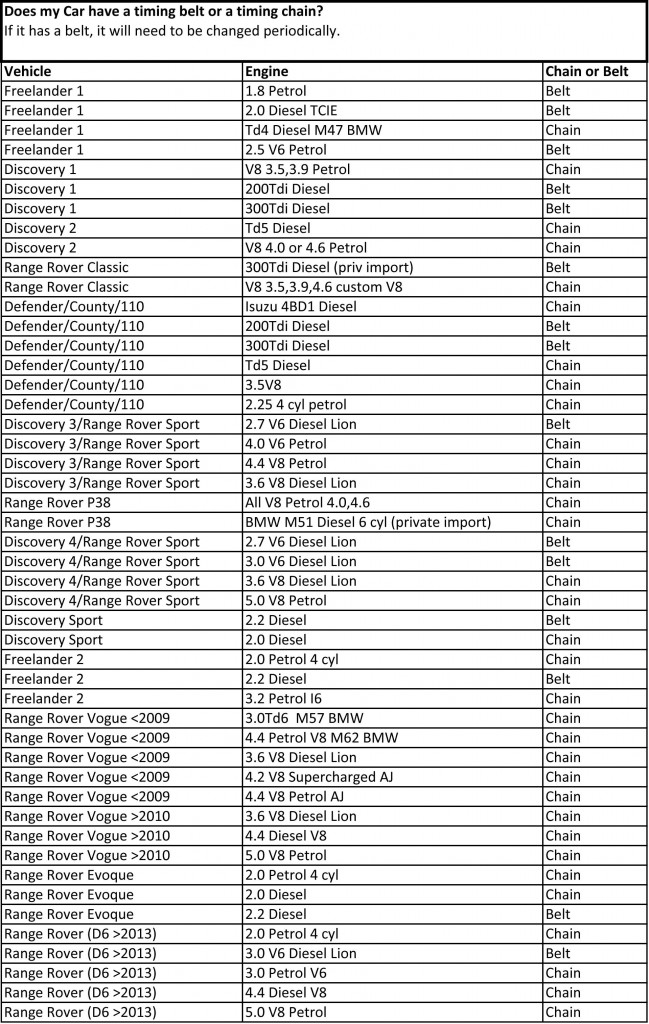Timing belt services – How do I know if my car needs one?
Here is a list of Land Rover Vehicles, showing whether or not they have a cam belt or timing chains.
Many engines have timing chains driving the valve gear. These chains are high quality material, guided by special chain guides, driving the cams on sprockets like push bike chains. These systems are lubricated by the engine oil system, and generally last the life of the engine until it gets overhauled when it gets tired after 300,000km or so. The only one to worry about is the 4.4 M62 V8 BMW found in the Range Rover Vogue. It has been known to break chain guides, and then the chain walks forward and chops the timing cover metal apart, filling the engine with aluminium shavings. This is a big job to clean out and the engine may as well be overhauled while it is out and apart. It is worth changing the chain and the guides by approximately 225,000 so as this will not happen. At Roverworks we can do this for you.
The cam belts are sturdy rubber belts that drive an engine’s valve system. Some vehicles have one belt, others 2 or 3. For example, the legendary 300Tdi diesel in the Discovery 1 has one timing belt. The Discovery 3 and 4 V6 Diesel engines have a big cam belt, as well as a high-pressure fuel pump drive belt that needs to be changed as well. The 2.5 V6 Petrol found in the Freelander 1 is also found in the Rover 75, and a similar MG branded car. It is actually a Kia engine, and was found in the Hyundai Santa Fe and Kia Carnival. Swapping the 3 belts on this engine can take up to 2 full days, and needs to be done regularly. Otherwise the engines fail and the car is scrap metal as they are not economically viable to repair.
Refer to the service manual for the service interval on all cam belt services. However if it’s been more than 100,0000km or 6 years as a rule of thumb – you are in the danger zone of it breaking. Not only are belts the things that break, but also there are idler and tensioner pulleys holding the belt in place, and these seize and break or throw the belt. The Discovery 3/4/Range Rover Sport diesel engines we see a lot of need the job done every 168,000kms.
Costs vary from about $900 for a 300Tdi through to about $2450 for a Discovery 4 2.7 or 3.0 litre depending on what has to be done.
As an example, the Discovery 3/4 diesels at Roverworks get a high pressure fuel pump belt and tensioner, cam belt and tensioner, 2 idlers, serpentine drive belt tensioner and idler, and we also change the top radiator coolant connector that has often been known to blow apart, drain all the coolant, and destroy the engine.
Why should I bother getting it changed? What happens is that as the pistons move up and down, the valves above need to open. They are not open when the piston is up as a rule. If the belt brakes, the valves stop moving, the pistons smash into the open valves pushed down, and break the valves/cams/rocker arms and shafts. Some engines are not worth repairing like the 2.5 V6 petrol, others like the Discovery 3 and 4 Diesels and the 300 TDI are worth repairing but it costs a lot of money. It will happen eventually if you don’t service the belts.
The story of Discovery 3 2.7 Diesels throwing belts from belt tensioners breaking off the front of the oil pump assembly under the timing cover is true. If you have a Discovery 3 that has not had its first belt change, it is best to change the oil pump with the latest part as well. The latest parts are thicker in the castings and so will not crack and lose the tensioner, slip the belts, and bust the engine up. I’ve seen it 3 times now. It is repairable, but the cost is awful for the customer.
Can I do it myself? Should I get the guy down the road to do it? Probably not. Many of these engines require special timing tools. We had one engine come in on its last legs after another mechanic had changed the cam belt – as it turned out he had misaligned the belt and started it, realised his problem and thought it he had gotten away with it. However, the left hand head valve gear then fell apart over the next week. We fixed it, but very disappointing for the customer. Yes it costs a bit to do it right professionally, but engines cost $10-$15K to repair or replace, which is not a good thing to have happen to you.
Bringing it to us is a great idea. Give us a call and we will fix it. We can arrange towing or trucking from country NSW or Vic, and certainly can easily get cars from Melbourne, Sydney Adelaide and Brisbane for specialist work. Considering the value of the car it is often worthwhile spending a few hundred on transport to fix a serious problem.
Happy motoring and I hope this helps answer someone’s questions.


